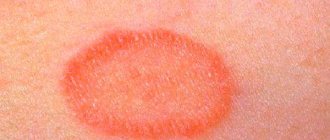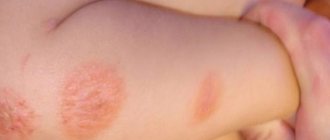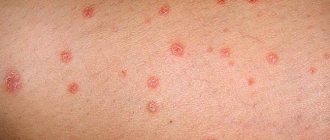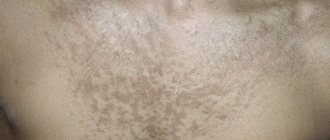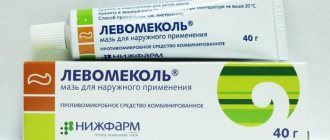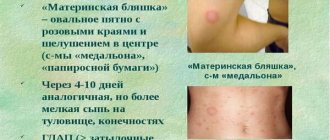Skin diseases caused by fungus cause discomfort to people and prevent them from leading a full life. The manifestations of this infection in the genital area are especially unpleasant, since peeling, itching and rashes restrict not only freedom of movement, but also interfere with a full sexual life.
Fungus on the scrotum is an unpleasant manifestation of a fungal infection that mainly affects men in the prime of life . Due to the delicacy of the problem and false shame, many are in no hurry to visit a doctor, hoping that the disease will go away on its own.
However, a miracle will not happen: the fungus must be treated, and under the strict supervision of a doctor and certain medications, which must be taken according to the regimen indicated by the doctor.
Causes of fungus on the testicles
Excessive sweating allows the fungus on the skin to actively develop if hygiene is ignored
The disease may not manifest itself for a long time, while living on the testicles, absorbing dead epithelial cells. Fungal activity can begin at any time; it is enough just for the infection to wait for the desired provoking factor:
- humid environment - in the scrotum it is created due to increased sweating and failure to comply with personal hygiene rules;
- high air temperature - this disease is especially important in the hot season, including in summer;
- excess body weight;
- impaired metabolism;
- the presence of untreated fungal infections;
- reduced immunity;
- frequent stress;
- presence of cardiovascular diseases;
- excessive sweating;
- predisposition;
- taking certain medications and sudden changes in diet or these medications;
- work in chemical production;
- frequent exposure to ionizing radiation (radiologists or men undergoing radiation therapy);
An important nuance for a fungal infection is the presence of concomitant diseases, such as tuberculosis, diabetes, oncology, hormonal imbalances and an immunodeficiency state. The risk of infection through contact with an infected animal or person cannot be excluded. Just a single contact is enough, after which the infection will have its hands free.
Infection with such an unpleasant disease occurs in the following ways:
- contact;
- household
Routes of infection
A man can become infected with such an unpleasant disease in two ways: contact and household. The infection will begin to actively multiply after unprotected sexual intercourse with a woman or the use of clothes or hygiene items. In this case, one contact with a surface that contains the smallest particles of the skin of an infected person is enough for the fungus to begin its active activity.
That is why men should take special care when visiting saunas, steam baths or any other public places. Constant use of tight underwear made of synthetic materials, as well as neglect of personal hygiene rules, is another factor that activates the disease.
Types of fungus that affects the scrotum
Varieties of the disease are based on the bacteria that provokes the disease, thus there are:
- The yeast type is the previous stage of candidiasis or the so-called thrush. The disease affects the area of the scrotum, penis and even the genitourinary canal.
- Epidermophytons are a provocateur of dermatomycosis or, more simply, lichen. Most often, this disease affects men who lead an active lifestyle. There are often cases when athletes face exactly this problem, since they sweat significantly in the groin area, thereby providing two fundamental factors for the disease: a humid environment and high body temperature.
- Pityrosporum is a pathogenic fungus that manifests itself in the form of pityriasis versicolor. The main cause of this problem is a change in hormonal levels and is much less likely due to the amount of progesterone in the body.
Reddish spots that itch and cause discomfort
By type of skin manifestations:
- Pityriasis versicolor - middle-aged people encounter it, while children under 7 years of age and elderly people are practically not susceptible to it. The risk of encountering this disease increases during periods of hormonal imbalance. This type of disease is especially dangerous during puberty. The provocateur of the testicular fungus of this group gathers in colonies, thus, smooth cream-colored bulges are observed in the groin.
- Lichen versicolor is a dermatological disease of an infectious nature and infection occurs through contact with a patient or his personal belongings (touching a sick animal is also true). At the same time, this group of fungus is characterized by low contagiousness, thereby posing an immediate danger to the skin of the scrotum.
White spots on the scrotum, red spot on the pubis or age spots in men
Often men are faced with the piquant problem of itching of the scrotum. And if with periodic, natural itching you can deal with the problem quickly, then in the case of continuing itching and the appearance of spots, you should not postpone a visit to a dermatologist.
White spots on the scrotum, as well as pink or red marks, can be signs of unpleasant fungal or infectious diseases.
What are the causes of spots on the scrotum and groin and how non-infectious pathologies of this kind are treated, we will discuss below in the article.
Signs of mycosis
Despite the fact that cutaneous mycosis is quite problematic in treatment, its manifestations are not long in coming. The problem is that the disease is prone to relapse after incorrect treatment. The disease can manifest itself in a variety of ways, but in the early stages the following occurs:
- small cracks appear on the skin in the scrotum area (on the inside of the thigh) (painful sensations depend directly on the characteristics of the body and the individuality of the case);
- the formation of bubbles is possible, due to which the skin becomes rougher and denser;
- over time, the pain may quickly pass, the skin will soften, return to its normal color and begin to peel off;
- under the condition of bacterial infection, in any case, the blisters will transform into ulcers.
All of the above signs are extremely general, but the following factors cannot be excluded: fungi on the testicles cause a feeling of itching, along with peeling off areas of the skin. Next, diaper rash appears, reddish spots appear, actively growing in size. Periodically, the spots begin to itch, causing discomfort, and all standard ointments for inflammation or disorder do not help. They only partially relieve inflammation and stress on the affected area, while the disease only temporarily stops progressing.
If left untreated, the fungus spreads to neighboring areas
Nutrition
A lack of microelements and vitamins in the diet can also be expressed in the form of unpleasant symptoms. Most often, redness and burning of the scrotum is observed if the menu is dominated by a large amount of fatty foods, as well as fast food.
If you notice an unpleasant symptom, which is not accompanied by any other complaints, then, first of all, it is necessary to exclude the influence of these above factors. But if the situation does not change after this, then you need to seek help from a dermatovenerologist.
Diagnostics
At first, it may seem that there is no particular point in diagnosis. “The first signs have appeared, which means it’s a fungus,” this is what most patients think when they come in with advanced groin fungus and numerous consequences of self-medication, such as skin burns and others.
First, everyone must undergo a full diagnosis, during which the doctor will be able to determine the stage of development of the disease along with the optimal method of treatment. The doctor first conducts an examination (dermatologist), examining the skin infected with the fungus. After this, the specialist directs the patient to scrape the lesion, examine the damaged area using a Wood's lamp and the Balzer test.
During the penultimate manipulation, a special device is used to highlight hidden problem spots of the epithelium. It is important to understand that the outcome of treatment, as well as the expenses incurred by the patient, depend on a complete diagnosis.
The Balzer test is a procedure for applying an alcohol solution of iodine to a problem area. Instead of this solution, aniline dyes are often used, which also highlight problem areas. After applying a special composition, the affected skin begins to peel off, which makes it possible to determine the stage and stage of development of the disease. Pityriasis versicolor, when illuminated with a special lamp, stands out as brown spots, and pityriasis versicolor shows up as mesh spots.
Iodine test - a simple and accessible diagnostic method
Tinea versicolor
Lichen versicolor is often confused by patients during self-diagnosis with other diseases with similar symptoms. At the moment there are three stumbling blocks, namely:
- leukoderma syphilitica – the spots are not brightly colored and have a mesh structure;
- roseola syphilitica - there is simply no peeling, the spots are pink in color and you just need to press on one spot and it disappears without the formation of frames, depressions, bubbles, pimples;
- imbricate mycosis - this disease is relevant in tropical climates, its spots are ring-shaped, the disease develops very quickly, affecting the entire area of the scrotum.
Pityriasis rosea in the groin
Pityriasis rosea in the groin is considered an infectious-allergic disease.
Its causative agent is considered to be herpes type 7. With this disease, round spots with clear boundaries appear on the body. Ringworm usually appears on the back, chest, limbs, and groin area. The disease occurs between the ages of 20 and 40 and affects men more often than women. This is due to increased sweating in the groin in males.
Causes
It is difficult to determine where lichen of Zhiber in the groin comes from. Although the disease is considered infectious, it is not transmitted to other people and the sick person is not contagious.
However, there are predisposing factors to the development of this pathology:
- recent acute respiratory viral infection;
- diabetes;
- frequent stress;
- diseases of the gastrointestinal tract;
- excess weight;
- impaired metabolism.
As can be seen from the list, the disease affects people with weak immune systems. Therefore, it is important to support the immune system:
- lead a healthy lifestyle;
- avoid hypothermia.
Signs
Typically, pityriasis rosea in the groin appears during the recovery period after a cold. The first spot, the “maternal plaque,” is the largest, up to 10 cm in diameter, its edges are bright red. The appearance of this spot is accompanied by a deterioration in the general condition of the patient.
Appears:
- weakness;
- headache;
- loss of appetite.
After a few days, a yellow coating appears in the center of the plaque, which dries over time and takes on the appearance of scales.
After 7-10 days from the onset of the disease, many small spots with a diameter of no more than 1 cm appear on the body. In the photo you can see that they have a regular oval shape and are not prone to merging.
Plaque and scales also form in small spots. The skin underneath becomes dry, cracks, and the patient feels discomfort and severe itching. The disease never affects the face, scalp or mucous membranes.
Recovery occurs 4 to 6 weeks after the first spot appears without special treatment. If the patient's immunity is greatly reduced, the disease can last up to 6 months with periods of exacerbation and remission.
After the lichen disappears, a pigment spot remains in its place, which will disappear over time. Long-term illness and improper hygiene can lead to a secondary bacterial infection and a deterioration in the patient’s general condition.
Diagnostics
Often when red spots appear, a person wonders what it could be? Lichen or fungus, but Zhiber's lichen can also be confused with other extremely dangerous diseases:
- measles;
- rubella;
- psoriasis;
- pityriasis versicolor;
- secondary syphilis;
The first 2 diseases (measles and rubella) are childhood infections, but their occurrence in an adult is also possible. Psoriasis, pityriasis versicolor and secondary syphilis are extremely serious diseases that, without timely and proper treatment, can lead to serious consequences.
Therefore, if you find pink spots on your body, it is better to contact a dermatologist to conduct a comprehensive examination and prescribe the right treatment.
Treatment
Treatment of pityriasis rosea can be divided into 2 types: general and local. General treatment involves the use of tablet forms of drugs.
These include:
- acyclovir is an antiherpetic drug, the main method of treating the disease;
- erythromycin is a broad-spectrum antibiotic;
- prednisolone is a hormonal drug;
- suprastin – antihistamine;
- enterosgel – sorbent;
- linex - bifidobacteria to restore normal intestinal microflora;
- immunomodulators and immunostimulants - to increase your own immunity;
- vitamin complexes.
Local treatment
For local treatment, a variety of skin treatment products are used.
- Tsindol is a zinc-based suspension. Reduces inflammation, dries the skin;
- Lassara paste – has an antibacterial and drying effect;
- Sinaflan - hormonal ointment;
- Akriderm GK is an ointment based on salicylic acid. Has an antimicrobial, anti-inflammatory effect.
In men, treatment may take a longer period of time due to increased sweating in the groin area.
Recommendations for patients with lichen Zhiber
If, after visiting a doctor, the diagnosis is confirmed, then for a speedy recovery the patient should follow some rules.
- Wear cotton, loose underwear. Tight synthetic panties will only aggravate the course of the disease and provoke a bacterial infection.
- Change underwear daily.
- Wash once a day. After a shower, gently dry the stains without rubbing them.
- If possible, provide access to fresh air to the affected areas.
- Stop playing sports until complete recovery.
- Eat right: remove allergenic foods from your diet, as well as fatty, smoked and pickled foods. Confectionery products are also prohibited.
For lichen rosea it is prohibited:
- bathe often;
- sweat;
- visit the pool and sauna;
- use soap and a washcloth;
- Do massage;
- use hormonal ointments for more than 2 weeks;
- scratch spots;
- wear synthetic clothing;
- sunbathe.
Prevention
Since the disease affects people with weak immunity, every person should be able to increase it.
To strengthen the immune system you need:
- Healthy food;
- exercise;
- harden.
After suffering from colds, it is recommended to use immunomodulators to help the immune system.
Conclusion
Zhiber's pink lichen in the groin area appears in people with reduced immunity. Some doctors believe that it does not need to be treated and will go away on its own.
Others recommend a whole range of medications. In addition, pityriasis rosea can be confused with other serious diseases. Therefore, to make the correct diagnosis and prescribe the correct treatment, you need to consult a dermatologist.
Source: https://venbolezni.com/smezhnye-problemy/rozovyiy-lishay-v-pahu.html
Treatment of scrotal fungus
The treatment period for a disease such as inguinal fungus is two months, but it is possible to completely safely speed up this process. Recommendations:
- purchase and wear loose underwear, changing it daily;
- use medicinal ointments only after taking a bath and washing the genitals with baby soap;
- treat infected and near-infected areas of skin with ointments;
- to avoid genital friction, use special talcum powder;
- shave your groin hair;
- avoid sexual intercourse during therapy (this is not only to protect yourself, but also your sexual partner).
Usually effective therapy is prescribed by doctors. It includes medication and the use of special ointments. The ointment is selected solely based on the type of disease and stage of development (volume of affected tissue).
Some people decide to use folk recipes to combat groin fungus, which, in principle, only gives the desired result in 20% of cases, especially if you have not consulted a doctor.
Traditional medicine involves the use of alcohol tincture of iodine for two weeks. You need to lubricate the affected area once a day, preferably before bed after a shower. The product has proven itself effectively in the fight against fungus; the main thing in the process is not to overdo it with the dosage.
Treatment of the disease
It’s easy for an experienced specialist to do the following:
- Collecting the patient's medical history.
- Thorough visual inspection.
- Makes a scraping.
A scraping made in men at an “interesting” place will help make an accurate diagnosis, and then decide on the method of therapy.
Treatment of such a disease usually occurs with the use of complex therapy. To do this, the doctor prescribes antibiotics and medications for internal use (tablets, capsules), as well as topical medications (creams, ointments, gels). In addition, medications are prescribed that can boost and strengthen the immune system. All this must be strengthened by regular hygiene of intimate places.
It is important to understand that the entire course of therapy must be completed, even if the symptoms have disappeared. Some patients do not adhere to this advice and quit treatment at the first improvement. Such actions threaten new occurrences of the disease in men, and the fungus may become much more resistant to medications.
Recommendation. You can avoid moisture and diaper rash in the scrotum by using talcum powder or powder, which have an antifungal effect.
Your doctor may prescribe fluconazole as a medication; this drug is most often used to treat fungus. In addition, it is effective against almost all types of infection.
The doctor also prescribes anti-inflammatory drugs to relieve redness in this area. If no ulcers or pustules appear during the development of the disease, you can treat the affected area with an iodine solution.
But you shouldn’t get too carried away, because you can get burned. Treatment in this method can be carried out as follows: for a week, iodine must be applied twice a day, and then an antifungal agent for another five days.
If the patient seeks help with an already advanced disease, medications are prescribed that can quickly relieve inflammation. Basically, these are ointments:
- Clotrimazole.
- Miconazole.
- Terbinafine.
